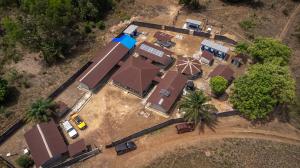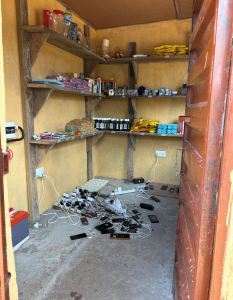
'HealthGrid Sustainability Fund' established to ensure the sustained impact of donor interventions in Sierra Leone
WASHINGTON, DC, UNITED STATES, November 4, 2024 /EINPresswire.com/ -- September marked the completion of “HealthGrid Sierra Leone” (HealthGrid), a USAID-supported Global Development Alliance helping bolster Sierra Leone’s public health system. A public-private partnership comprising RESOLVE, Orange Sierra Leone, World Vision Sierra Leone, Gavi, and Sierra Leone’s Ministry of Health and Sanitation (MoHS), HealthGrid provides solar power and internet connection to 26 health facilities in remote communities across Sierra Leone, eight of which also benefit from improved water, sanitation, and hygiene (WASH) facilities provided by World Vision.
Often in the development sector, the close of a grant period can mean the end of the intervention. This is not the case for HealthGrid, where a key characteristic of the program is a focus on providing for the long-term operation and maintenance (O&M) of installed equipment.
“We know that the real challenge is not installation, it’s upkeep,” says HealthGrid Director, Richard Schroeder. “It’s easy to install a modem, but who pays for the monthly ISP fees? It’s one thing to install a solar array, but what happens when a battery needs to be replaced? The fact is, we are already seeing these O&M challenges with equipment we installed less than a year ago. We know these solar panels can last 10 years or more, but the community won’t see their full benefit if the system breaks down due to lack of maintenance. Too often, donors install equipment and walk away, leaving the O&M costs to communities or governments lacking the means to cover them. We’re committed to creating a mechanism to keep the equipment we’ve donated working.”
Today, HealthGrid demonstrated that commitment by establishing the “HealthGrid Sustainability Fund”, a ring-fenced account dedicated exclusively to providing for the long-term O&M of the energy, internet, and WASH equipment provided to health facilities.
Initially capitalized by an $150,000 contribution from RESOLVE, the intent is to keep the fund solvent through productive uses of the equipment itself. “We recognize that these systems are assets that can be used to foster economic activity in the community and generate revenue, revenue that can be used to maintain the systems,” says Schroeder.
For example, in Dambala community in Bo District, a HealthGrid built kiosk sells water and device charging services, made available by HealthGrid equipment, to residents, of which a portion of the revenue generated will feed back into the HealthGrid Sustainability Fund.
Members of the Dambala village expressed excitement about the kiosk and also underscored the real challenge of maintaining equipment in remote areas. Community leaders were hopeful about the HealthGrid sustainability model and its emphasis on creating pathways for the community to contribute to, and ultimately own, system maintenance.
Stable power, connectivity and WASH are fundamental to healthcare and public health systems – enabling, for example, light during nighttime births, improved water and sanitization at key points of care, and enhanced vaccine access and storage capabilities to remote facilities dealing with unvaccinated children or those working to catch-up on vaccinations. Connectivity allows vital health outcomes data to be more quickly and consistently communicated and aggregated for disease monitoring and response.
This underlying infrastructure also positions health facilities for other interventions. Indeed, Dambala is already seeing a multiplier effect. The health facility recently received an oxygen concentrator from UNICEF, in part because they now have the electricity to power it. Currently overseen by a Board of public and private stakeholders, including representatives from MoHS’s Integrated Health Projects Administration Unit (IHPAU) and Expanded Programme on Immunization (EPI), ownership and management of the HealthGrid Sustainability Fund will eventually be assumed by the Government of Sierra Leone.
“Ultimately, we see this as a government asset meant to sustain equipment at public facilities,” says HealthGrid Sustainability Fund Board Chair, Sheka Forna. “While we’re grateful for RESOLVE’s initial contribution, our goal is to attract additional contributions, including from government and other donors. New equipment is flashy, but maintaining existing equipment is less disruptive and more cost efficient. It requires thinking beyond funding cycles and grant periods. We’re eager to partner with other organizations interested in innovative solutions to maximize the impact of development dollars.”
Maurice Ferenkeh Koroma, Special Advisor to the Minister of Health said, “As a Ministry we are keen on going green and have set ourselves and ambitious target that by 2030 we want all our healthcare facilities to have solar systems as their main source of electricity. However, as we are building these systems we must also be thinking about suitability. We recognize O&M as a fundamental problem affecting the long-term impact of many of the generous donations made by our international partners. We view this Sustainability Fund as an innovative model for addressing those problems. We hope that other health development partners will adopt this model for the solar systems they fund”
Building on the success and lessons learned from HealthGrid, health facility electrification is being expanded in Sierra Leone under Power Africa’s Health Electrification and Telecommunications Alliance (HETA), who are working to expand the intervention to an additional 60 sites; progressing toward HETA’s larger goal of providing power and connectivity to 10,000 health facilities across sub-Saharan Africa.
“As we roll out HETA in Sierra Leone, we take cognizance of the challenges with long-term O&M and remain committed to addressing them by incorporating market-based approaches to generate revenue and support financial stability initiatives that will facilitate seamless O&M of installed equipment, thereby ensuring continuous electricity supply and digital connectivity at our health facilities.
By leveraging the work done by HealthGrid, the Sustainability Fund remains an integral part of our approach to funding O&M. We will adapt and extend this model to support all facilities built under HETA; and continue to work with RESOLVE to scale up the existing Fund by securing additional resources to cover more facilities. This underscores our dedication to improving overall health service delivery using renewable energy solutions and improved digital connectivity,” says Femi Coker, HETA’s Chief of Party in Sierra Leone.
Richard Schroeder
RESOLVE/HealthGrid
rschroeder@resolve.ngo
Distribution channels: Banking, Finance & Investment Industry, Energy Industry, Healthcare & Pharmaceuticals Industry, Human Rights, International Organizations
Legal Disclaimer:
EIN Presswire provides this news content "as is" without warranty of any kind. We do not accept any responsibility or liability for the accuracy, content, images, videos, licenses, completeness, legality, or reliability of the information contained in this article. If you have any complaints or copyright issues related to this article, kindly contact the author above.
Submit your press release

